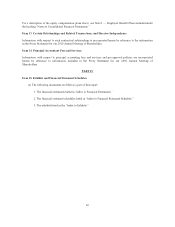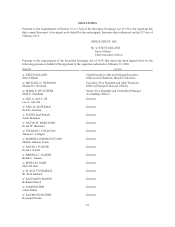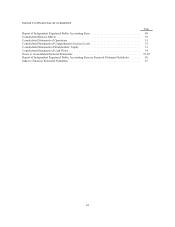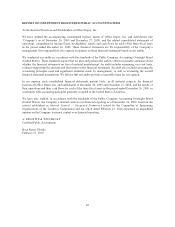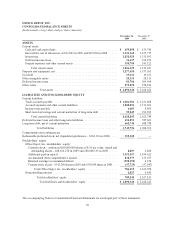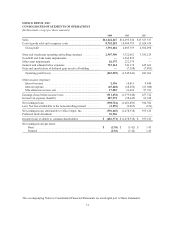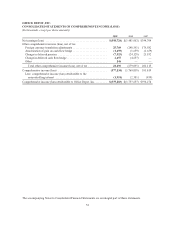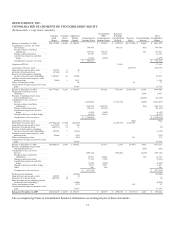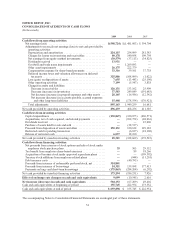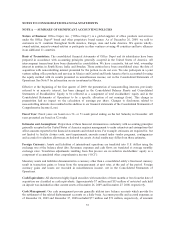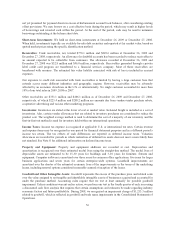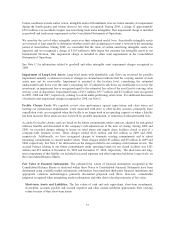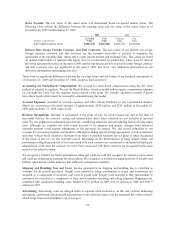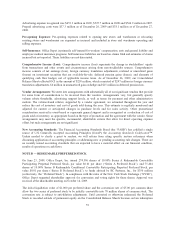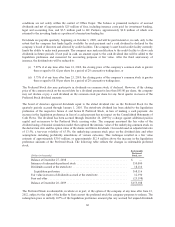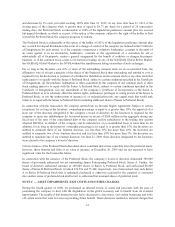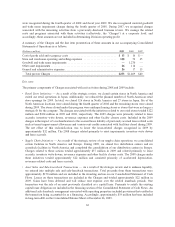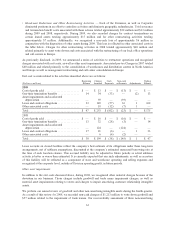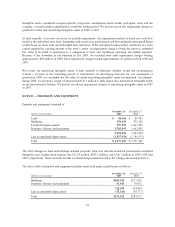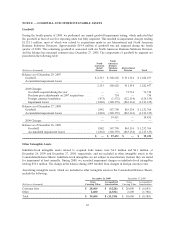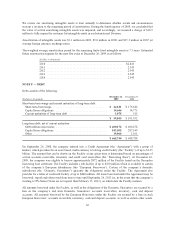Office Depot 2009 Annual Report Download - page 58
Download and view the complete annual report
Please find page 58 of the 2009 Office Depot annual report below. You can navigate through the pages in the report by either clicking on the pages listed below, or by using the keyword search tool below to find specific information within the annual report.not yet presented for payment drawn in excess of disbursement account book balances, after considering existing
offset provisions. We may borrow on a cost effective basis during the period, which may result in higher levels
of borrowings and invested cash within the period. At the end of the period, cash may be used to minimize
borrowings outstanding at the balance sheet date.
Short-term Investments: We held no short-term investments at December 26, 2009 or December 27, 2008.
When held, investments typically are available-for-sale debt securities and reported at fair market value, based on
quoted market prices using the specific identification method.
Receivables: Trade receivables, net, totaled $770.1 million and $849.6 million at December 26, 2009 and
December 27, 2008, respectively. An allowance for doubtful accounts has been recorded to reduce receivables to
an amount expected to be collectible from customers. The allowance recorded at December 26, 2009 and
December 27, 2008 was $32.8 million and $46.0 million, respectively. Receivables generated through a private
label credit card program are transferred to a financial services company. Most of these receivables are
transferred with recourse. The estimated fair value liability associated with risk of loss is included in accrued
expenses.
Our exposure to credit risk associated with trade receivables is limited by having a large customer base that
extends across many different industries and geographic regions. However, receivables may be adversely
affected by an economic slowdown in the U.S. or internationally. No single customer accounted for more than
10% of our total sales in 2009, 2008 or 2007.
Other receivables are $351.1 million and $406.1 million as of December 26, 2009 and December 27, 2008,
respectively, of which $225.4 million and $288.2 million are amounts due from vendors under purchase rebate,
cooperative advertising and various other marketing programs.
Inventories: Inventories are stated at the lower of cost or market value. In-bound freight is included as a cost of
inventories. Also, certain vendor allowances that are related to inventory purchases are considered to reduce the
product cost. The weighted average method is used to determine the cost of a majority of our inventory and the
first-in-first-out method is used for inventory held within our international operations.
Income Taxes: Income tax expense is recognized at applicable U.S. or international tax rates. Certain revenue
and expense items may be recognized in one period for financial statement purposes and in a different period’s
income tax return. The tax effects of such differences are reported as deferred income taxes. Valuation
allowances are recorded for periods in which realization of deferred tax assets does not meet a more likely than
not standard. See Note G for additional information on deferred income taxes.
Property and Equipment: Property and equipment additions are recorded at cost. Depreciation and
amortization is recognized over their estimated useful lives using the straight-line method. The useful lives of
depreciable assets are estimated to be 15-30 years for buildings and 3-10 years for furniture, fixtures and
equipment. Computer software is amortized over three years for common office applications, five years for larger
business applications and seven years for certain enterprise-wide systems. Leasehold improvements are
amortized over the shorter of the estimated economic lives of the improvements or the terms of the underlying
leases, including renewal options considered reasonably assured at inception of the leases.
Goodwill and Other Intangible Assets: Goodwill represents the excess of the purchase price and related costs
over the value assigned to net tangible and identifiable intangible assets of businesses acquired and accounted for
under the purchase method. Accounting rules require that we test at least annually for possible goodwill
impairment. Unless conditions warrant earlier action, we perform our test in the fourth quarter of each year using
a discounted cash flow analysis that requires that certain assumptions and estimates be made regarding industry
economic factors and future profitability. During 2008, we recognized an impairment charge of $1,213.3 million
related to goodwill, which is reflected in goodwill and trade name impairments in the Consolidated Statements of
Operations.
56


